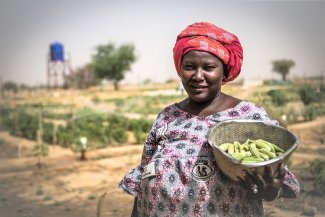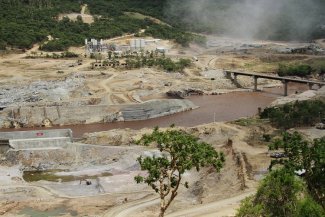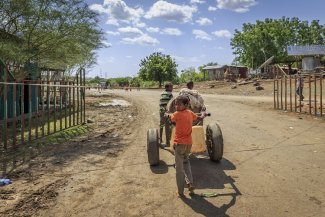A farmer in Ghana uses an electric pump system to irrigate his carrot crops with groundwater.
“Many small-scale farmers in the Dakar region struggle to profit fully from agriculture because they cannot afford to pay for a drilling system to tap into the groundwater supplies,” says geographer Fatimatou Sall, director of the WASH (water, sanitation and hygiene) programme for Catholic Relief Services and president of Senegal’s Association of Young Water and Sanitation Professionals. Like the rest of the African continent, groundwater here is “invisible, little known, rarely taken into account in decision-making and poorly understood by the people”, adds Abou Amani, director of UNESCO’s Division of Water Sciences. As such, it holds largely underexploited economic potential.
According to the UN World Water Development Report 2022 produced by UNESCO, only 5 per cent of the land used for irrigation in sub-Saharan Africa uses groundwater, compared to a world average of 38 per cent, 59 per cent in North America, 57 per cent in South Asia and 35 per cent in North Africa. In the industrial sector, the extraction of groundwater for use in mineral extraction and processing, and the textile and energy sectors ranges from 5 per cent in Africa, to 57 per cent in Europe, and 17 per cent globally.
Worldwide, groundwater, which constitutes almost 99 per cent of all liquid freshwater reserves on earth, provides half of the water extracted for drinking water, agriculture and industry. A very small proportion is utilised on the African continent. And yet, contrary to popular belief, sub-Saharan Africa has an abundance of large aquifers. Researchers estimate that the volume of groundwater reserves is one hundred times greater than the annual renewal of the region’s surface freshwater resources. The report estimates that Africa has 2.72 million km3 of liquid freshwater at an average depth of 90 metres, behind Asia (3.69 million km3) but ahead of South America (1.29 million km3) and Europe (541,000 km3). The level of groundwater resources is particularly high in central Africa.
The potential of this groundwater is worth harnessing, especially as the continent’s groundwater resources are resilient to climate change and are of good quality, according to a study conducted by the French Institute for Research and Development (IRD) in partnership with University College London on nine African countries – Benin, Burkina Faso, Niger, Ghana, Tanzania, Uganda, Zimbabwe, Namibia, South Africa.
Lack of investment
“Groundwater resources in Africa are very diverse. It is found in abundance in sedimentary basins, in porous rocks that form large sponges, in the Dallol region of Niger, for example, or in Senegal. This groundwater is also found in basement rock areas, in fractures and cracks in the parent rock, which is much more difficult to mobilise and the volumes of which are hard to ascertain from the research conducted to date. In Guinea, for example, there are areas of schist, weathered source rock at great depths,” says Christophe Léger, hydrogeologist and deputy managing director at Vergnet Hydro, a French company specialising in the supply of drinking water in Africa.
Aside from the lack of detailed knowledge about the volume of groundwater resources in Africa, use of these resources is hampered by a lack of investment in infrastructure, institutions, the training of professionals and the search for innovative solutions.
“The abundant groundwater in sedimentary basins is underutilised and could be put to better use in agriculture if farmers were able to use modern techniques such as subsurface drip irrigation applied directly to the roots, which helps prevent evapotranspiration,” says hydrogeologist Léger.
“Twenty million hectares in Africa could be devoted to agricultural irrigation through the use of groundwater. That’s nine times more than [the amount] currently irrigated,” adds Yvan Altchenko, a lecturer and researcher at the AgroParisTech engineering school.
“It is not very expensive to extract water from a hundred metres below the ground. A borehole costs around US$10,000. But then you need a pump and energy to draw the water. And the installation has to be maintained. These costs and the cost of the energy used need to be covered to ensure profitability. There is no classic economic model for this type of activity,” Léger explains.
A solution for sustainable and job-creating agriculture
Not only could groundwater be used to supply drinking water to people, especially in rural areas, and meet their growing needs; it could also be used to promote sustainable agriculture with an increase in irrigated areas, productivity and yields, and crop diversification; as well as to develop an industrial sector around the harnessing of this water, to develop aquaculture and the textile industry, and to create jobs.
In a few months, by December 2022, the 21,000 inhabitants of the communes of Fakouna, Karo and Lah, in the Mouhoun province of Burkina Faso, will have access to safe and monitored drinking water, drawn from underground using electric pumps connected to solar farms, installed by Vergnet Hydro. These three new drinking water supply systems will create around 150 new jobs. The French company already employs 400 people in Burkina Faso.
“We are recruiting standpipe operators, meter readers, centre managers, electromechanics, plumbers, cashiers and guards, using local labour wherever possible,” says Lucie Kabore, Vergnet Hydro’s operations manager in Ouagadougou.
At the age of 32, this hydraulics engineer, who trained in Burkina Faso and Morocco, coordinates the company’s operational activities in five regions, overseeing five operations managers, some 50 centre managers and around 350 women standpipe operators. “We use local labour as much as possible, recruiting people from the local communities. We do, however, struggle with some of the job profiles. In the area of maintenance, we are looking for plumbers who can work on the supply system, which requires a broader knowledge than just sanitary plumbing, and we are also looking for energy technicians and electromechanics to work on generators or photovoltaic plants,” says Kabore.
Job stability is also an issue. The women standpipe operators earn a percentage of the takings (usually around 10 per cent), which may not be enough to live on if demand at the standpipe is low.
The long-term viability and sustainability of the groundwater use model also needs to be considered. In South Africa, 70 per cent of the population, or around 45 million people, depend on groundwater. The country’s mining industry, which needs water for its operations, is encountering increasing hostility from local communities.
“Groundwater storage in most West and Central African countries is low, but annual rainfall is high and so there is regular recharge. By contrast, many southern African countries have considerable groundwater storage, despite the very low recharge rates. This storage provides an important buffer. However, current groundwater pumping will ultimately be at the expense of future generations, and the economic, financial and environmental aspects of depleting storage should not be overlooked,” warns Richard Connor, editor-in-chief of the UN World Water Development Report at UNESCO.
Competing water needs
In the Western Cape, a legal battle has been going on since 2017 between the West Coast Environmental Protection Association (WCEPA) and Kropz Plc, over the commissioning of its phosphate mine. Although dismissed by the Water Tribunal in September 2021, the WCEPA continues to challenge the legality of a water use licence, which is essential for mineral processing and allows Kropz to tap into the Elandsfontein aquifer.
“Where recharge is low, certain activities such as mining need to be controlled. An outright ban would be too drastic because the volumes of water available are very large. But the more you tap into that groundwater, the lower the water table gets, making it more expensive to pump – which could become a problem in terms of affordability for non-professional users,” Connor says.
Such challenges are likely to increase with global warming, demographic pressure and growing urbanisation. In the Dakar region, which draws nearly 30 per cent of its water resources from aquifers, much of the groundwater is used for the supply of drinking water, agriculture and increasingly for industry.
“These groundwater resources are crucial for Senegal, but they are threatened by their combined use and overexploitation. We are seeing salinisation problems, the water table level is falling, and the water is being contaminated by wastewater given the lack of sanitation infrastructure,” warns Sall.













